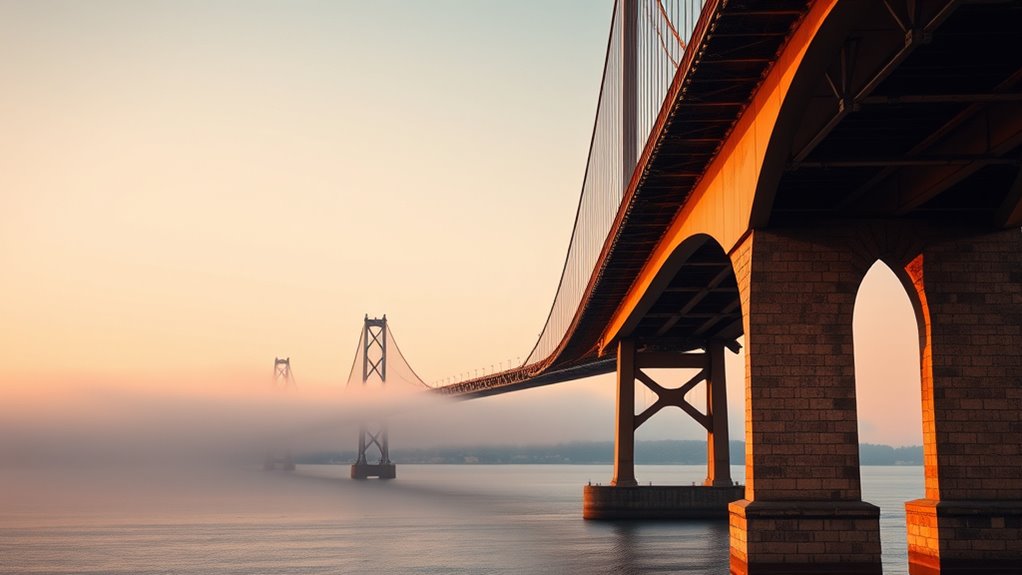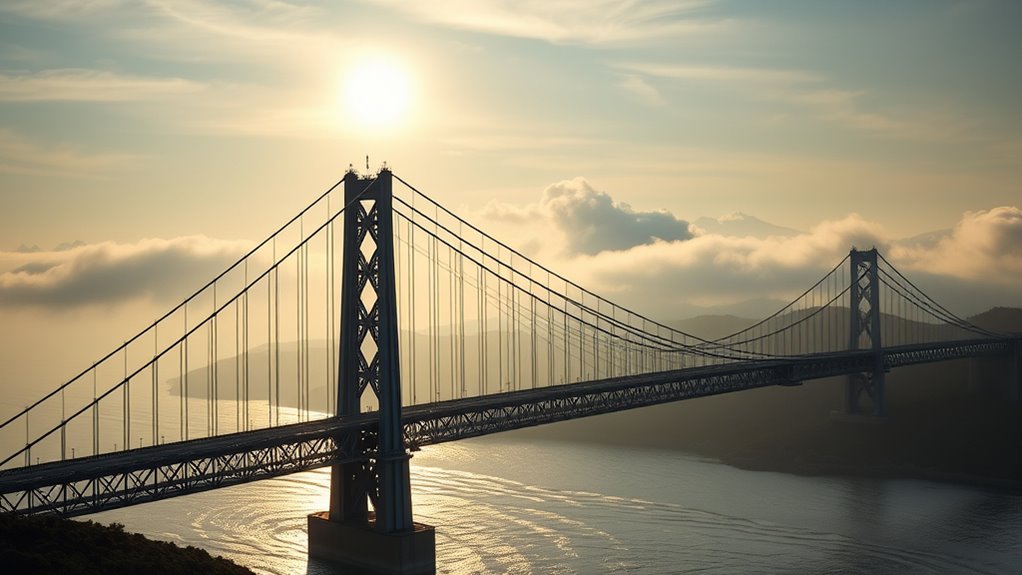Dreams of bridges often symbolize your desire for passage, connection, and progress. They reflect your hopes for unity, overcoming obstacles, and moving toward new opportunities. Bridges in dreams can embody your journey between different parts of yourself or your life, offering a sense of crossing into fresh beginnings. If you stay curious, you’ll discover how different cultural meanings and personal perceptions shape these powerful symbols of hope and change.
Key Takeaways
- Bridges in dreams symbolize transitions, personal growth, or crossing into new phases of life.
- They represent connections between different aspects of oneself or relationships with others.
- Dreaming of bridges can indicate overcoming obstacles or bridging gaps in understanding.
- Such dreams often reflect hope, progress, or the desire for unity and harmony.
- Cultural symbolism of bridges enhances their interpretation as gateways to new opportunities and spiritual portals.

Bridges serve as essential links that facilitate movement and connection between different places, ideas, or phases. They are more than just structures of steel and concrete; they embody cultural symbolism that reflects the values, history, and aspirations of societies. When you look at a bridge, you’re witnessing a physical manifestation of human ingenuity and collective identity. Throughout history, bridges have symbolized unity, progress, and the bridging of divides—whether geographic, social, or ideological. In many cultures, they represent hope and transition, serving as gateways to new opportunities or domains of understanding. This symbolic significance deepens as you consider different cultures’ unique interpretations of bridges, from the ancient Chinese use of the Moon Bridge as a spiritual portal to the Roman arches signifying strength and stability. The architectural evolution of bridges mirrors technological advancements and changing aesthetic priorities. You can trace this evolution from simple, natural materials like wood and stone to modern marvels crafted from steel and reinforced concrete. Early bridges were often utilitarian, built swiftly and with limited resources, yet they laid the groundwork for more intricate designs. As engineering knowledge expanded, so did the complexity of bridge structures — from suspended bridges to cable-stayed and arch designs. Each new development reflects a desire not only for functionality but also for beauty and innovation. When you observe a modern suspension bridge spanning across a wide river or deep valley, you’re witnessing centuries of architectural evolution that combines engineering prowess with artistic expression. These structures often become icons of their cities, symbolizing progress and resilience. The evolution of bridge architecture also showcases technological breakthroughs, such as the use of new materials and construction techniques, enabling you to cross previously insurmountable obstacles. Every new bridge design pushes the boundaries of what’s possible, emphasizing the human drive to connect and transcend limitations. Additionally, the incorporation of natural materials, such as wood and stone, in early bridge designs highlights a harmonious relationship with the environment that many modern structures seek to emulate. Every new bridge design pushes the boundaries of what’s possible, emphasizing the human drive to connect and transcend limitations. As you reflect on these structures, consider how their design influences not just transportation but also cultural perception. Bridges can inspire awe and admiration, fostering a sense of collective achievement. They serve as physical reminders that connection and passage are integral to growth, both personal and societal. Whether standing on a historic stone bridge or gazing at a futuristic suspension span, you’re witnessing the ongoing story of architectural evolution intertwined with cultural symbolism—an enduring proof to our desire to bridge gaps and forge new paths forward.
Frequently Asked Questions
How Do Bridges Symbolize Emotional Transformation?
Bridge symbolism often represents emotional transformation, as it signifies your journey through change and growth. When you dream of crossing a bridge, it indicates you’re actively working through emotional healing, moving from one state of mind to another. You’re connecting past experiences with your future self, embracing transformation. These dreams encourage you to trust the process of change, recognizing that bridges serve as powerful symbols of overcoming obstacles and fostering inner healing.
Can Bridges Represent Cultural or Societal Connections?
Bridges, like ribbons weaving through a community, symbolize cultural or societal connections. They embody architectural symbolism, representing unity and shared identity. You see this in how bridges link diverse neighborhoods or countries, fostering infrastructural unity. These structures remind you of the importance of connection, acting as tangible links that bring people together across differences, and highlight how collective efforts can build bridges that strengthen societal bonds and promote understanding.
What Role Do Bridges Play in Personal Growth Narratives?
Bridges in personal growth narratives symbolize your road crossing from one phase to another. They represent overcoming obstacles and embracing change through their architectural design, which often reflects strength and resilience. When you see a bridge in your dreams or life, it suggests you’re actively connecting different parts of yourself or your journey. Use this symbol to recognize moments of progression, growth, and the courage it takes to cross into new possibilities.
Are There Specific Types of Bridges Associated With Particular Transitions?
Sure, some bridges seem to scream “big moment” with their architectural symbolism, like suspension bridges for daring leaps or stone arches for steady progress. Structural engineering highlights how certain types, like drawbridges or pedestrian crossings, are perfect for specific conversions—embodying change or connection. So, yes, your mental bridges might just be as specialized as your life’s milestones, each designed for a particular leap or pause in your journey.
How Do Different Cultures Interpret the Symbolism of Bridges?
Different cultures interpret the symbolism of bridges through their unique architectural symbolism and historical significance. In Western traditions, bridges often symbolize progress, connection, and overcoming obstacles. In Asian cultures, they represent spiritual passage and harmony. Native American beliefs see bridges as sacred pathways between worlds. You see, these diverse perspectives highlight how cultural backgrounds shape the understanding of bridges, making them powerful symbols of unity, change, and cultural history across societies.
Conclusion
Just like crossing a bridge transforms a journey, embracing change connects you to new possibilities. Imagine standing at the edge of a rickety bridge, hesitant but knowing the other side promises growth. That leap might be intimidating, but it’s where transformation happens. Remember, every bridge you cross isn’t just about reaching a destination—it’s about becoming someone stronger and more connected. So, take that step; the other side is waiting with open arms.








